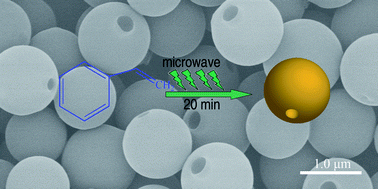Issue 11, 2011Previous ArticleNext Article
One-step template-free synthesis of monoporous polymer microspheres with uniform sizes via microwave-mediated dispersion polymerization†
Ming-Qiang Zhu,*aGan-Chao Chen,bcYun-Mei Li,bJun-Bing Fan,bMing-Feng Zhua and Zhiyong Tang*c Author affiliations
Abstract
One-step facile synthesis of monoporous polymer microspheres via microwave-controlled dispersion polymerization is introduced. This template-free method employing the dispersion polymerization of styrene under microwave irradiation induces directly the formation of uniform monoporous polymer microspheres, with controllable morphologies and sizes, which can be tuned by simply adjusting parameters for the synthesis. A comparison to conventional heating indicates that microwave irradiation plays a vital role in the formation of this novel morphology.

Deep Subwavelength-Scale Light Focusing and Confinement in Nanohole-Structured Mesoscale Dielectric Spheres
Yinghui Cao 1, Zhenyu Liu 2, Oleg V Minin 3 4, Igor V Minin 5Affiliations expand
- PMID: 30717306
- PMCID: PMC6409861
- DOI: 10.3390/nano9020186
Free PMC article
Abstract
One of the most captivating properties of dielectric mesoscale particles is their ability to form a sub-diffraction limited-field localization region, near their shadow surfaces. However, the transverse size of the field localization region of a dielectric mesoscale particle is usually larger than λ/3. In this present paper, for the first time, we present numerical simulations to demonstrate that the size of the electromagnetic field that forms in the localized region of the dielectric mesoscale sphere can be significantly reduced by introducing a nanohole structure at its shadow surface, which improves the spatial resolution up to λ/40 and beyond the solid immersion diffraction limit of λ/2n. The proposed nanohole-structured microparticles can be made from common natural optical materials, such as glass, and are important for advancing the particle-lens-based super-resolution technologies, including sub-diffraction imaging, interferometry, surface fabrication, enhanced Raman scattering, nanoparticles synthesis, optical tweezer, etc.